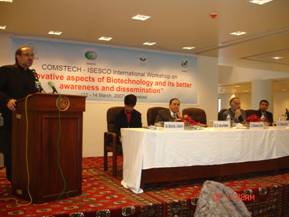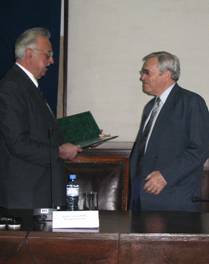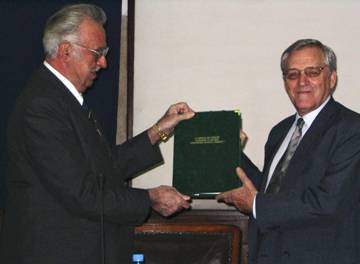|
|||||
 |
|||||
|
|||||
NewsGLOBAL[Top]
EUROPEAN COMMISSION, IFAD TO INCREASE INVESTMENT IN AGRIC As a means of eradicating rural poverty in developing countries, the European Commission (EC) and the International Fund for Agricultural Development (IFAD) pledged an increased investment in agriculture. The outcome of the meetings between the President of IFAD and senior officials of the EC will serve as a common platform from which the two organizations can identify and develop joint programs and investment in the sector of agriculture, rural development and food security that have the highest impact on rural poverty reduction. Proposed areas of focus will include rural finance and remittances, natural resource management including land degradation and desertification, livestock management, pro-poor market access, and agricultural research. The complete press release is available at http://www.ifad.org/media/press/2007/20.htm. [Top]
APPLICATIONS OF BIOTECH TO FOREST PRODUCTS DEVELOPMENT The utility of biotech in enhancing the range of forestry products ranges from development of trees with enhanced resistance to insects and diseases to producing modified wood. However, Bob Kellison of the Institute of Forest Biotechnology in the United States, believes that the applications of biotech in forestry can go a lot further. Kellison stated that other modified traits that may have greater impact include an increased ability for photosynthesis to help increase carbon sequestration in the atmosphere, and also traits that will help increase biomass production to supply bioenergy needs. There is also a need for research to develop trees with increased tolerance to abiotic stresses such as high salinity and drought. This will allow currently unsuitable land areas to be planted with forest tree species. Though gains from biotechnology applications in forest trees may not be realized quickly due to the longer growth cycle of many species, Kellison believes that results will ultimately help to “support health and long life in an era when conventional crops will be insufficient to meet the needs of Earth’s expanding population.” The complete article was published in Euphytica and accessible to subscribers at http://www.springerlink.com/content/72072834651383l4/ AMERICAS[Top]
The Colombian Institute of Agriculture (ICA) has authorized the controlled planting in specific areas of the country of two biotech insect-resistant maize varieties, Yieldgard and Herculex. These GM varieties have been approved for human and animal consumption, and for food processing, following biosafety, health and food safety, and socio-economic studies carried out by CTNBio, the Colombian Technical Committee on Biosafety. CTNBio comprises members from the Ministry of Environment, Housing and Development; the Ministry for Agriculture and Rural Development; the Ministry of Social Protection; the Colombian Institute for the Development of Science and Technology (Colciencias) and ICA. The approval requires a minimum distance of 300m between the GM and conventional varieties, and GM varieties cannot be planted in protected indigenous areas. For more information contact Osiris Ocando at osiris.ocando@agrobio.org. [Top]
PIONEER, IOWA STATE TO FORM BIO-BASED INDUSTRY CENTER Iowa State University and Pioneer Hi-Bred International, Inc. have agreed to collaborate on a bio-based products industry center that will help meet the challenges faced by a bio-based economy. The proposed center at Iowa State will complement efforts of business and government in developing technologies based on agricultural feedstocks. Research on the economic and business aspects of a bio-based economy will be conducted in the center. "This is a very significant gift from Pioneer which will help us leverage support from other funding sources for a bio-based industry center," said Gregory Geoffroy, Iowa State University president. "We are excited to be partnering with Pioneer and others to create this center to help facilitate the expansion of the bio-based products industry." Iowa State University was the first university in the United States to establish a graduate program in biorenewable resources and technology and offers one of the few master’s and doctoral degrees in this field. Read the press release at http://www.pioneer.com/web/site/portal/menuitem.3a564de45522eec23f869d21d10093a0/. [Top]
GROWERS CAN CONTINUE TO GROW AND USE ROUNDUP READY ALFALFA UNTIL… Many farmers planning to use Roundup Ready alfalfa will be affected by a preliminary injunction, according to Monsanto Company. The preliminary injunction was issued in a lawsuit currently pending in the U.S. District Court for the Northern District of California. In this case, the court had previously ruled that United States Department of Agriculture had failed to follow procedural requirements of the National Environmental Policy Act in granting non-regulated status to Roundup Ready alfalfa under the Plant Protection Act, and would have to prepare an Environmental Impact Statement. The March 12 preliminary injunction order allows continued harvest, use and sale of Roundup Ready alfalfa, but placed limits on the purchase and planting of seed until further hearings are held. Growers who have already purchased Roundup Ready alfalfa as of March 12 have only until March 30 to plant. After the deadline, farmers must plant non-genetically engineered alfalfa. Sales of Roundup Ready alfalfa seed are prohibited after March 12 pending the court's decision on permanent injunctive relief. The press release is available at http://monsanto.mediaroom.com/index.php?s=43&item=469. [Top]
UPDATES REGARDING CLEARFIELD 131 LONG-GRAIN RICE SEED The presence of trace levels of unauthorized genetic material in Clearfield 131 (CL131) rice seed was confirmed by a separate test by the U.S. Department of Agriculture’s (USDA) Animal and Plant Health Inspection Service (APHIS). Based on these test results, further distribution or planting of 2005, 2006, or 2007 registered or certified CL131 seed is prohibited. APHIS is issuing emergency action notifications (EANs) to distributors of 2005, 2006, or 2007 registered or certified CL131 rice seed to prevent further distribution and planting of the seed. Producers who have already planted CL131 seed this season prior to this announcement may consider treating with an herbicide or mechanically destroying the plants after emergence. A different variety of rice or a broadleaf crop such as soybeans can then be planted in its place. To read more: http://www.aphis.usda.gov/newsroom/content/2007/03/CL131update3-9-07.shtml. [Top]
DON’T CRY – HEALTHY ONIONS ARE HERE TO STAY Whoever said that onion soup is good must have known the real nutritional value of an onion – it contains copious heart-healthy compounds, antioxidants and soluble fiber. Michael Havey, a scientist with the United States Department of Agriculture Agricultural Research Service (ARS) has been trying to bring out these good qualities in onions. Thiosulfinates, a group of blood-thinning compounds that can bust up platelets that might otherwise form troubling plugs at sites of vascular damage, is the reason behind the pungency of onions. Fructans are a source of soluble fiber shown to reduce rates of colorectal cancers, while onion flavonoids, such as quercetin, show proven antioxidant activity. Havey and colleagues are looking for genes that increase the levels these compounds in onions, and they have recently discovered one that helps onions accumulate the fibrous fructans. Havey has also identified a gene that coordinates the buildup of sucrose in onion bulbs. This means it may be possible to boost the veggie's naturally sweet flavors, while still increasing the compounds that are linked to good health. Readers can access the news article at http://www.ars.usda.gov/News/docs.htm?docid=1261. [Top]
DEVELOPING LARGE DATASET FOR RICE PLANT USING SMALL RNAs Researchers at the University of Delaware have developed a large dataset of gene sequences in rice, which will help promote an increased understanding of how genes work in rice, a staple food for much of the world's population. Using advanced gene sequencing technologies and high-powered computer-based approaches, plant biologist Blake Meyers and colleagues examined both normal gene expression (via messenger ribonucleic acids, or mRNAs) as well as small ribonucleic acids (small RNAs) in rice. For many years small RNAs were considered unimportant because of their size, but small RNAs are now known to play an important role in gene regulation. "Small RNAs also have been associated with other important biological processes, such as responses to stress," Meyers said. "Many of small RNAs in rice have related sequences in the many important cereal crop plants, including maize and wheat." Research on small RNAs is being seen as a leading edge in plant biotechnology. The news release is available at http://www.nsf.gov/news/news_summ.jsp?cntn_id=108455&org=olpa&from=news. [Top]
PRESENCE OF ASIAN SOYBEAN RUST IN IOWA FIELD CONFIRMED Soybean plant tissues submitted to the Iowa Soybean Rust Team was found to be infected with Asian soybean rust. It was the first time the disease has been documented in an Iowa field since it was reported in the United States in 2004. The fungus and the spores that cause the disease cannot survive without green leaf tissue and will die during Iowa winters. The recently discovered rust fungus does not pose a risk of infection for the 2007 growing season in Iowa. "This discovery reminds us that it is possible for Iowa fields to become infected with this disease," said David Wright, director of contract research at the Iowa Soybean Association. "Nonetheless, growers should not overreact to this development. Instead, growers must be ready to act appropriately and economically in 2007 should this disease again show up in Iowa and be a threat to soybean yields." ASIA AND THE PACIFIC[Top]
INDIA EXTENDS SUSPENSION OF RULE ON GM SOYBEAN OIL IMPORTS The Directorate General of Foreign Trade (DGFT) of the Government of India has suspended a rule that requires imports of genetically modified soybean oil to be cleared by the biotech regulatory authority (GEAC) until 31 Dec 2007. The notification in this regard was issued on 13 March 2007 to nullify the Condition No. 18 of Chapter 1A (General Notes Regarding Import Policy) under the Foreign Trade Policy (2004-09) issued on 7 April 2006. The first moratorium on new regulation for import of GM products by amending Schedule – I (Imports) of the ITC(HS) Classifications of Export and Import Items, 2004-09 under the Foreign Trade Policy (2004-09) was imposed from 20th April 2006 which was due to expire of end of this month. The country imports about two million tons of soybean oil mostly from Brazil and Argentina, where genetically modified soybeans are widely grown and consumed. The Ministry of Commerce and Industry notifications:
For more information: b.choudhary@isaaa.org [Top]
NO HARMFUL EFFECT OF BT COTTON SEEDS SAYS INDIAN AGRIC MINISTER While responding to parliamentary query on harmful effects of genetically modified (GM) seeds, the Indian Minister of State for Agriculture Sh Kanti Lal Bhuria informed that “no harmful effect of Bt cotton seeds on human and animal health, plant life and environment has been reported”. Bt cotton is the only GM crop approved for commercial cultivation by the Genetic Engineering Approval Committee (GEAC) in the Ministry of Environment and Forests, on the basis of environmental and bio-safety evaluations. Bt cotton seeds are being produced and marketed in the country by private seed companies. The Government has organized Public Awareness Programmes to educate the farmers about the risks and benefits associated with the GM crops, he added. See the Press Information Bureau (PIB) press release: Genetically Modified Crops at http://pib.nic.in/release/release.asp?relid=25794. For more information contact: b.choudhary@isaaa.org. [Top]
TRENDS IN ADOPTION OF NEW TECHNOLOGY BY INDIAN FARMERS - STUDY A study published by Glenn Stone, professor of anthropology and of environmental studies at Washington University in St. Louis, sheds light on the impact of new technologies on farmers and local culture. The study focuses on cotton production in the Warangal District of Andhra Pradesh, India, one of the nation's key cotton-growing areas. Stone found several factors affecting farmers' ability to adjust to new developments by practical methods. Among them are the speed of change, the overwhelming number of choices in the seed market and the desire for novelty. "Very few farmers were doing experimental testing, they were just using it because their neighbors were," Stone says. "There has been a breakdown in the process of farmers evaluating new seed technologies." Stone's research reveals that the increase market share of Bt cotton resulted not from traditional farming methods of testing seed for efficacy, but from a pattern of "social learning" — farmers relying on word of mouth to choose seeds. To read more: http://news-info.wustl.edu/tips/page/normal/8887.html [Top]
REGIONAL CONSULTATION ON BIOTECH COTTON: OPPORTUNITIES FOR SMALL SCALE FARMERS Would the adoption of Bt technology be beneficial for small scale farmers in Pakistan and other developing countries? What are the factors that need to be assessed by scientists and policy makers in order to determine the likely benefits and risks of adoption of the technology? What lessons could be learned from the experiences of other developing countries who have already adopted the technology? These were some of the topics discussed last week in Faisalabad, Pakistan, during a Regional Consultation on Biotech Cotton. Participants agreed that although Bt cotton is potentially very beneficial to farmers, other factors in addition to the availability of the technology need to be considered to ensure successful adoption. Among these requirements are:
The workshop “Regional Consultation on Genetically Modified Cotton for Risk Assessment and Opportunities for Small-scale Cotton Growers” was funded by the Common Fund of Commodities, and was organized by the International Cotton Advisory Committee (ICAC), the National Institute for Biotechnology and Genetic Engineering of Pakistan (NIBGE), and the International Service for the Acquisition of Agri-Biotech Applications (ISAAA). The event was attended by cotton experts from over 25 countries, mainly from Asia and South East Africa. For more information contact Randy Hautea, ISAAA global coordinator, at r.hautea@isaaa.org. [Top]
PAKISTAN GOVT TO SUPPORT S & T COMMUNICATION The Pakistan government, through the Federal Ministry for Information and Broadcasting, has committed the use of its radio and television station to devote regular broadcast spots to developments in science and technology (S & T). In addition, the country is set to establish a media university to produce a core of communication practitioners who would be able to help generate information on S and T. This was announced by Federal Minister for Information and Broadcasting Muhammad Ali Durani during the opening ceremonies of the international workshop on “Innovative aspects of biotechnology and its better awareness of biotechnology and its better awareness and dissemination” in Islamabad, Pakistan.
Minister Durani said that highlighting science and technology news through daily 2-3 minute plugs is part of the government’s interest in increasing public awareness and interest in various scientific areas. “It is the responsibility of the government in Pakistan and the Moslem world to focus awareness on new technologies, notably biotechnology”, Durani stressed. He added that also in the pipeline is a television science program that would combine science and entertainment. The workshop, organized by Organization of Islamic Countries Standing Committee on Scientific and Technical Cooperation (COMSTECH), Islamic Educational, Scientific and Cultural Organization (ISESCO), Pakistan Biotechnology Information Center, and the International Service for the Acquisition of Agri-biotech Applications (ISAAA), was attended by journalists and representatives from Bangladesh, Egypt, Indonesia, Iran, Malaysia, Pakistan, and the Philippines. For more information about the workshop email Dr. Anwar Nasim, COMSTECH science adviser and overall workshop coordinator, at anwar_nasim@yahoo.com. [Top]
LONG-TERM AGREEMENT TO PROTECT THOUSANDS OF RICE VARIETIES The International Rice Research Institute (IRRI) and the Global Crop Diversity Trust recently unveiled a new agreement that will involve the annual dispersal in perpetuity of US$600,000 to help fund the protection and management of the world’s thousands of unique rice varieties. The funding agreement is expected to help conserve and manage forever the extraordinary diversity of arguably the world’s most important crop. At least 80,000 distinct rice varieties are carefully stored at IRRI’s T.T Chang Genetic Resources Center. The collection is considered the Institute’s “crown jewels” and is kept in a special earthquake-proof and fireproof facility that must be maintained at temperatures as low as –19 degrees Celsius. Under the agreement, IRRI has pledged to designate a portion of its financial assets to generate $400,000 in annual income that will be invested in the genebank, which will unlock $200,000 from the Trust each year. The money will be used to acquire any rice varieties not currently in the repository and to ensure the storage systems for long-term conservation are up to international standards. Readers can access the news release at http://bulletin.irri.cgiar.org. [Top]
NEW COTTON VARIETIES DEVELOPED BY CSIRO CSIRO has been developing cotton varieties with improved disease resistance which effectively combat Bacterial Blight and Verticillum Wilt. Varieties resistant to Cotton Bunchy Top are now being developed, and a watching brief is maintained on other diseases like Alternaria. With the aid of gene technology, CSIRO has been successful in breeding genetically modified (GM) insect resistant and herbicide resistant cotton varieties using traits from Monsanto. Gene technology will be used to speed up the screening and development of new conventional and transgenic varieties. With conventional breeding, CSIRO has substantially improved cotton yield and fiber quality. Fiber quality, particularly strength, length and 'micronaire' (a measure of fineness and maturity), is critical in maximizing returns to growers and accessing premium markets. CSIRO’s cotton breeding research has increased cotton fiber strength by 20 per cent, and cotton fiber length by about five per cent, enabling the Australian cotton to compete in the higher quality end of the world export market. Read the article at http://www.csiro.au/science/ps8b.html. EUROPE[Top]
GREEN BIOTECH MANIFESTO LAUNCHED To let Europe benefit from the opportunities of agricultural biotechnology, or "green biotechnology", action to open the European market is needed from European leaders. This was stressed by EuropaBio Chairman, Dr Hans Kast, at the launching of the Green Biotech Manifesto during a gathering of European biotech industry leaders in Lyon, France. The Green Biotechnology Manifesto is a European perspective on green biotech and advocates five main policies to support agricultural biotech in Europe. The industry calls on decision makers to fully implement the biotech crop authorization process; enable a European single market in seeds; respect other countries’ freedom to trade in commodities; promote coherence of policies and public information on green biotech; and promote policies that respect developing countries. Visit EuropaBio for the news and links to the press release at http://www.europabio.org/ne_Greenmanifesto130307.htm [Top]
CLIVE JAMES HONORED BY ROMANIAN ACADEMY Leaders from the Academy of Agricultural and Forestry Sciences in Bucharest presented Dr. Clive James, chairman of the ISAAA Board of Directors, with its most prestigious honor - the distinction of “Academic Merit” for James' “outstanding contribution to a safer environment and more sustainable agricultural development by biotechnology transfer to the developing world.” James was at the academy to present a lecture on the commercialization status of biotech crops and future prospects at the invitation of Professor Cristian Hera, President of the Academy. The presentation titled "The Commercialization of Biotech Crops 1996 to 2006, and Future Prospects," offered an overview on the global status of biotech crops, which are now planted in 21 countries meaning more than half the world's population of 6.5 billion reside in areas where biotech crops are cultivated.
Research[Top]
DEADLY PROTEIN AS NEW NATURAL INSECTICIDE Nematode worms are known to infect and kill insect pests with the help of a bacterium that thrives inside their intestine. It was only recently that researchers at the University of Warwick, together with their colleagues at Coventry and Nottingham Universities, discovered the mechanism of how the bacterium kills an unwitting victim with a protein. The protein, XptA1, was formed from four subunits in the shape of a hollow cage or box. This shape allows the protein to bind specifically to a part of the gut of cabbage white butterfly caterpillar, a pest for many growers. The hollow shape allows the protein to act as a receptacle for two other proteins, and this ensemble forms a poison “complex” that is 300 times more toxic to the caterpillars than XptA1 would be by itself. The researchers also discovered other variants of this family of toxic proteins that targeted other insects. This new family of naturally occurring proteins offers an alternative to current commercial protein-based insect toxins that are now starting to meet some resistance, according to Dr Sarah Lee from the University of Warwick. Read the news release at http://www2.warwick.ac.uk/newsandevents/pressreleases/secret_of_worms/. [Top]
BT, NON-BT MAIZE COEXISTENCE TESTED IN GERMANY Results of a pre-commercial field scale trial conducted in 30 sites in Germany demonstrated that coexistence between Bt maize and the non-transgenic counterpart is possible. The study conducted by W. E. Weber and colleagues at the Martin Luther University, showed that levels of the transgene in the grains of the non-transgenic maize can be kept below 0.9 percent, the threshold level for labeling GM products in the European Union. The group of Weber grew maize in field sites ranging from 0.3 to 23 hectares in size. In all areas, a Bt maize hybrid containing transgenic event MON810 was planted in the middle of the field and surrounded by non-Bt maize. The maize flowering times were overlapping. During harvesting, the researchers obtained plant samples from the non-Bt maize located 0 to 60 meters away from the Bt maize. The DNA of the samples was analyzed by two diagnostic laboratories where real-time PCR was used to detect the levels of the transgene. The study has determined that no samples from the conventional maize collected beyond 10 meters had levels of GM above the threshold of 0.9 percent. The researchers recommend that planting 20 meters of conventional maize as a pollen barrier between adjacent fields is sufficient in managing the outcrossing between Bt and non-Bt maize. Subscribers to the Journal of Agronomy and Crop Science can access the full article at http://www.blackwell-synergy.com/doi/abs/10.1111/j.1439-037X.2006.00245.x [Top]
DEVELOPMENT OF GOLDEN INDICA RICE VARIETIES Researchers at the International Rice Research Institute (IRRI) in the Philippines discussed in their review paper the progress toward the development of Golden Rice IR64 and BR29, both indica rice types. The transgenic rice lines express b-carotene and other carotenoids in its endosperm resulting to the observed yellow-orange color. The IRRI researchers presented results of screenhouse evaluations conducted in the Philippines and Bangladesh of the rice varieties Golden IR64 and Golden BR29. The transgenics were found to have enhanced carotenoid content compared to control varieties but are similar in other agronomic characters, such as plant height, days to flowering, seed set, 100-seed weight and total biomass. The levels of b-carotene in the transgenic IR64 and BR29 were determined to be 2.32 μg/g and 9.34 μg/g, respectively. The researchers assert that further research to determine bioavailability and grain quality needs to be conducted in larger field tests. In addition, the freedom to operate in Southeast Asia will speed up the delivery of the golden rice to consumers who will benefit most. The abstract in the journal Euphytica, with links to the full article for subscribers, can be accessed at http://www.springerlink.com/content/b5r6781167t7115n/ [Top]
JAPAN INTERNATIONAL AWARD FOR YOUNG AGRIC RESEARCHERS The Ministry of Agriculture, Forestry, and Fisheries (MAFF) of Japan launched the search for “Japan International Award for Young Agricultural Researchers.” The award aims to increase motivation among young researchers contributing to research and development in agriculture, forestry, fisheries, and related industries in developing countries. Candidates for the award should be non-Japanese researchers under 40 years old who work for research institutions outside Japan. Winners will receive a testimonial and cash incentive of USD5000 and will be invited to Japan for the awarding ceremonies in September. For more information, visit: http://www.jircas.affrc.go.jp/english/event/h19/h19boshu_e.html |
|||||



